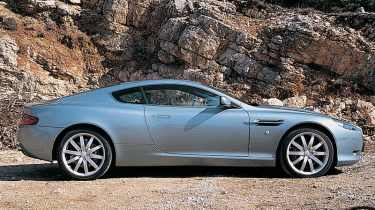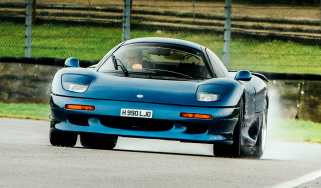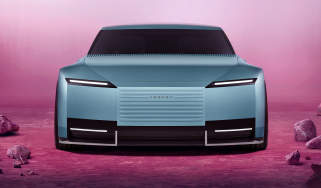Jaguar ALC concept: Ways To Skin A Cat
There's no doubt about it, the new Jaguar Advanced Lightweight Coupe (ALC) concept - essentially the shape of the forthcoming XK replacement - is a terrific looking car: purposeful, elegant and bang up to date. But haven't we seen this look somewhere before, at Aston perhaps? That was the thorny question on everyone's lips when the ALC made its debut at the Detroit Auto Show in January and it was the same question being asked at the Geneva show last month.
There's only one person who can provide the definitive answer and that's Jaguar's chief designer, Ian Callum, formerly of Aston Martin, the man responsible for the look of the Jaguar ALC and several of the current Astons. evo caught up with him at Geneva and asked The Question. 'I'd agree the profile of the two cars are very similar,' admits Callum, 'but the first thing you've got to take stock of is that we've got legal requirements to adhere to, which are very demanding - pedestrian protection, unbelted occupants, sight-lines, all that stuff. 'These things manifest themselves as absolutes on a car like this - you've got to have a four-degree sight-line, not four-point-one or four-point-two. And in 'pedestrian' you're going into millimetres of package to get it right - making sure there's enough space in the right places. So you have all these absolute numbers and in a saloon car you've got more room to manoeuvre because they're bigger all over. But with a front-engined, rear-wheel-drive sports car your packaging is right at the absolute minimum tolerances. 'So by default you end up with a very similar profile. I think it's that profile that people are actually commenting on. And also I have certain rules that influence the peripheral edges of that profile. The grille, for instance, should be straight at you, and this is one thing I absolutely insist on. An E-type came straight at you - whack - and so does a DB7, so does a DB5, so does a Zagato. The noses of these cars don't droop, and that in itself sets up the front of the car, the graphic of the car. 'The profile kind of sets-up by default; it's a front-engined, classic two-plus-two coupe so the combination of the default and some of my own rules set up something, which, in atmosphere, probably feels familiar. 'But where the differences are for me is that the Aston DB9 is a very tailored car, very linear. Yes, it's got a bit of wedge in the DLO (Daylight Opening, the side-glass), but it's very tailored - the crease lines and the fenders (wings) are actually quite soft but very structured in terms of their profile. And they are very horizontal; they tend to come to an edge and then come down. Tailored is how Aston should be regarded - look at a DB4 and you'll see that it's a very tailored car, too. Now, when you come to Jaguar, there's something a lot more voluptuous to deal with and that's where the difference comes in. 'People say, 'Well, they've both got haunches.' Yes, the DB4 and the E-type do both have haunches but their executions are totally different. I think that's just part of the genre, minimalising the packaging of a two-plus-two sports car, but the form language is completely different. There's no way that I could put form like that of the ALC onto an Aston. It's too vibrant, it's alive, while an Aston is much more tailored, much more serious. 'So, the Aston and Jaguar are both quite different in my mind. Some people have said the ALC is maybe too subtle and that's something I'll have to live with, but I don't really mind. In time, people will understand it. That's not arrogance, it's just a knowledge of the way that things are when you get so focused on it. 'The ALC is deliberately much more of a showy car than an Aston; an Aston is about restraint and understatement. The ALC has understatement in the control of its surfaces, but it's a bit more upbeat in terms of its profile, and that's what Jags are about, you know.' So what does Callum imagine that William Lyons, Jaguar's founder, would have made of the ALC's design? 'I think that he'd like it,' opines Callum, 'and I think he'd understand it. He wouldn't be fearful of it at all; if anything he'd probably say 'push it a bit more.' I'd have to say, 'yeah, but you haven't seen what we've got to deal with now, give us a break.'. The heritage of the brand is obviously important, so what are the key, quintessentially Jaguar elements that Callum has had to incorporate into his designs? 'I learned my trade by looking at Jaguars, far more than I did looking at Astons - funnily enough when we did the DB7 everybody said 'that looks too much like a Jag' for that reason. It's about proportions, it's about stance. And I think the curvaceousness of this car is not necessarily something you'd see on an Aston. It's very controlled and very 'constructed'. That's Jaguar, always has been, but it's also a bit of me as well because I think in three dimensions, I don't think in two dimensions.' Callum makes some interesting points and it's clear that the overall form of cars like Jag and Aston coupes is shaped as much by regulatory issues as by designers. Yet whereas Callum is able to see distinct differences between the coupes he's designed, those with a less keen eye for minute detail may still have problems distinguishing between them. However, regardless of any possible similarities with an Aston, having seen the production version of the new Jag XK in the metal, I can tell you it looks terrific. In fact, its frontal aspect is even more powerful and menacing than that of the ALC; it should be another cracker for Callum's CV.








